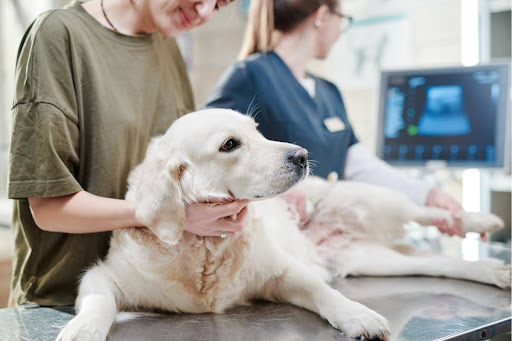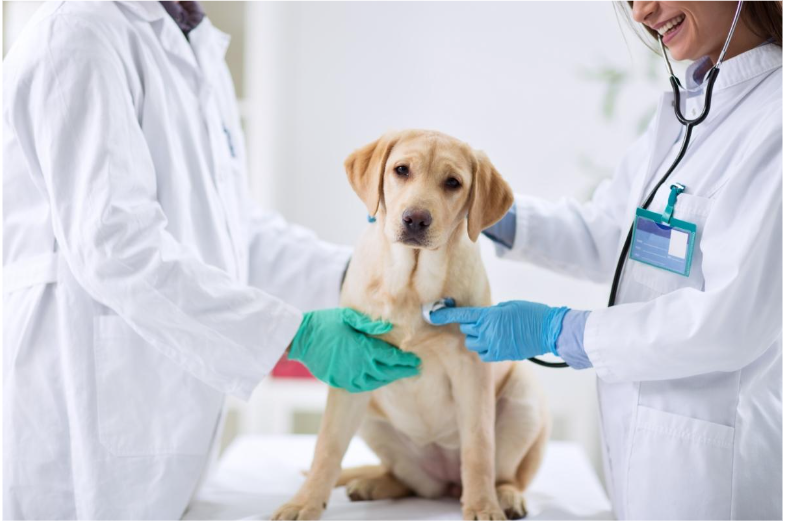Much like in humans, your furry friend’s kidneys play a crucial role in their overall health. These organs not only filter waste from the bloodstream but also regulate blood pressure, make the hormone called erythropoietin for red blood cell production, and keep minerals like potassium and sodium balanced. But, when the kidneys start to fail – it can cause a lot of health problems for your dog. Kidney failure in dogs is a big issue and it can show up suddenly or slowly over time.
Chronic Kidney Disease (CKD) might happen to any dog, but it’s more common in older ones. In fact, up to 10% of dogs in veterinary care facilities might have it, but in the general pet population, it’s less common, around 1%. Keeping this in mind, knowing the signs of kidney disease in dogs & how to prevent and treat it is key to helping them live longer and happier. Even with kidney failure, with the right care, dogs can still have a good life for many months or even years. And it depends on how early the disease is caught and its progression rate.
So keep reading to find out why kidney health is so important for dogs, what causes kidney failure, what the symptoms look like, and how you can take care of a dog with this condition.
Understanding Renal Failure in Dogs
Kidney failure in dogs, also called renal failure, is when their kidneys can no longer efficiently perform their important functions. These functions are really crucial, like:
- Getting rid of toxins in the body.
- Keeping the right amount of water and salts.
- Making sure blood pressure and acidity are okay.
- Helping make red blood cells.
This condition can stem from various diseases affecting the kidneys and related organs. At first, this is called renal disease – where the kidneys are damaged but still working a bit. But, as things get worse, it turns into renal failure, meaning the kidneys stop working completely. And this is very bad for your dog’s health.
It’s really important for dog owners to know that kidney problems are serious. But, there are often ways to deal with it and maybe even help your pet live longer with the right vet care. Catching the problem early & starting treatment right away is super important.
Kidney Failure Types in Dogs
Kidney failure in dogs, a serious health issue, falls into two primary categories: acute renal failure and chronic renal failure. Knowing these types can help dog owners figure out the risks and what treatments might help.
-
Acute Renal Failure
This kind of kidney failure happens all of a sudden, usually in just a few hours or days. It’s often caused by toxins or infections that cause a rapid decline in kidney function. Symptoms can be severe and appear abruptly. But, there’s a bit of good news with acute renal failure – it can sometimes be reversed.
If treated right away and promptly, there’s a chance for the dog to fully recover. And, it’s super important to find out what caused the problem, which could be anything from kidney stones, cancer, or eating something poisonous.
-
Chronic Renal Failure
On the other hand, chronic renal failure is a problem that gets worse over a long time. It’s characterized by a gradual loss of kidney function over weeks, months, or even years. This usually happens because of getting older and the kidneys naturally wearing out. All dogs’ kidneys will stop working well at some point. But for some dogs, it happens faster.
Unlike acute renal failure, you can’t reverse chronic renal failure. But, if you catch it early and start treatment, you can make the damage to the kidneys worse more slowly & keep the disease from getting bad too fast. It’s tricky because dogs often don’t show signs of kidney problems until a lot of damage is already done. And since dogs have more kidney tissue than they need just to get by, spotting the problem early is hard.
Stages of Chronic Renal Failure
The progression of chronic renal failure is typically divided into four stages, as defined by the International Renal Interest Society (IRIS). These stages are defined by things like blood waste product levels and urine abnormalities. The further along the stage, the more noticeable the symptoms become, and, sadly – the shorter the expected survival time is.
- Stage 1: This is the very beginning, where the kidneys start to lose their ability to work properly. And, dogs in this stage can live more than 400 days on average.
- Stage 2: Here, the drop in kidney function becomes more obvious. The survival time for dogs at this point varies from 200 to 400 days.
- Stage 3: By this stage, kidney function is significantly compromised. The time a dog might have left drops to between 110 and 200 days.
- Stage 4: This is the last stage, where the kidney disease has become severe. The average survival time now falls between 14 and 80 days.
It’s really important to know that the outlook gets worse and the expected survival time gets shorter as the disease moves from one stage to the next.
End-Stage Renal Disease: When chronic kidney disease gets to the end-stage renal disease, things look pretty grim. At this point, the few working parts left in the kidneys (called nephrons) are overwhelmed, trying to make up for the parts lost to damage or old age. But eventually, they can’t keep up, leading to very serious symptoms & a much shorter survival time.
So for dog owners, understanding these stages of kidney failure is key. It helps in catching the problem early and stepping in to help.
Causes of Kidney Failure
Kidney failure in dogs is a big health issue, and it comes from many different causes. It’s really important for dog owners to know about these causes so they can catch and deal with problems early.
- Genetic Predisposition: Some dog breeds are just more likely to get kidney diseases because of their genes. So knowing which breeds are at risk can help owners watch out for signs of kidney trouble.
- Age-Related Degeneration: Just like people, dogs get older and their bodies start to wear out, including their kidneys. This wearing out over time is a common reason for chronic kidney failure, where the kidneys slowly stop working as well.
- Environmental Factors: Exposure to harmful substances plays a significant role. Dogs can suffer from kidney damage due to ingestion of toxic foods, chemicals, or drugs. This is often the cause of acute renal failure – where kidney function decreases rapidly.
- Dental Disease: It might be surprising, but bad teeth and gums can lead to serious kidney problems. Bacteria from dental disease can get into the blood and affect the kidneys, which shows why keeping your dog’s teeth clean is so important.
- Bacterial Infections: Diseases like leptospirosis, which dogs can get from dirty water, can make their kidneys inflamed. And this inflammation can damage the cells & lead to kidney failure.
- Congenital Diseases: Some dogs are born with kidney problems, like missing kidneys or having kidney cysts. And these issues from birth can affect their kidney health right from the start.
So all these things can lead to kidney failure in dogs. By knowing these causes, dog owners can take steps to prevent problems or catch them early, which is key to keeping their dogs healthy and extending their lives.
Symptoms of Renal Failure in Dogs
Spotting the symptoms of kidney failure, also known as renal failure, in dogs is super important for getting them help on time. Kidney failure shows up in different ways – sometimes quickly or slowly over time. And for dog owners, paying close attention to these signs is key to finding & handling the problem early.
-
Early Signs of Chronic Kidney Disease
Chronic kidney disease, which develops over months or years, may initially present subtle signs that gradually become more severe. These include:
- Increased Thirst and Urination: One of the first things you might notice is your dog drinking & peeing more than usual. This occurs because the kidneys lose their ability to conserve water effectively.
- General Malaise: Dogs may show signs of depression or lethargy because of toxins building up in their blood that the kidneys can’t clean out.
- Weakness: Dogs can also feel weak because of not having enough potassium in their blood, which is a problem caused by impaired kidney function.
-
Advanced Symptoms of Renal Failure
As kidney disease gets worse and turns into renal failure, the signs become much more serious and clear. These include:
- Weight Loss and Reduced Appetite: It’s common for dogs to lose a lot of weight and not want to eat as much when the disease gets worse.
- Vomiting and Diarrhea: These symptoms happen a lot and can make the dog even weaker.
- Oral Health Issues: If your dog’s gums look pale, which can mean they’re anemic, or if they have sores in their mouth – it’s a sign of advanced kidney failure.
- Changes in Behavior: You might notice your dog moving clumsily like they’re stumbling around, or acting like they’re drunk.
- Abnormal Odor: Breath that smells like chemicals is a telltale sign of toxin build-up in the bloodstream.
- Urinary Changes: Both an increase and decrease in the volume of urine are possible, sometimes even leading to incontinence.
- Visible Blood in Urine: Seeing blood in your dog’s pee is serious & means you need to get them to a vet right away.
- Lethargy and Seizures: If your dog is very tired all the time or has seizures, it’s a sign of very advanced kidney failure.
Catching the problem early and getting treatment started is key. And, if you see any of these signs in your dog, you need to talk to your vet right away. Getting the right diagnosis & starting treatment early can really help manage the disease and make your dog’s life better.
Critical Importance of Veterinary Diagnosis: It’s important to know that while these symptoms can suggest kidney failure, they might also be signs of other health issues – like diabetes. Getting a vet to check your dog is crucial to figuring out exactly what’s wrong and how bad it is. And, the kind of kidney failure (acute or chronic), how much kidney function they’ve lost & what’s causing the problem all matter in figuring out how to help them.
Diagnosing Kidney Disease in Dogs
Diagnosing kidney disease in dogs is a critical step in managing their health. Your veterinarian will typically begin with a thorough physical examination followed by specific diagnostic tests.
Here’s what they often use:
- Blood and Urine Tests: These tests are the main way to find kidney disease. They check for abnormalities that might point to a problem with the kidneys. Even though significant kidney damage may occur before these tests show anything is wrong – they’re still very important for figuring out what’s going on.
- Blood Pressure Measurement: Dogs with chronic kidney disease often have high blood pressure. And this makes checking blood pressure a helpful way to find out if there’s a kidney problem.
- Imaging Tests: Tools like ultrasound or X-rays let the vet look at the kidneys directly. They can see if the kidneys are the wrong size or look weird, which helps them understand how bad kidney failure is.
- Advanced Testing for Early Detection: There are some new ways to find kidney disease earlier than before, which is vital for effective management.
After figuring out that a dog has kidney disease, vets use blood tests to find out what stage the disease is in. Knowing the stage helps the vet decide the best way to treat your pet.
Treatment Options for Renal Failure in Dogs
The treatment of renal failure in dogs is multifaceted and depends heavily on the stage and severity of the disease. It’s good for dog owners to know about these treatments so they can work well with their vets to take care of their dogs.
-
Dietary Management
What your dog eats is important when they have kidney disease. Vets who specialize in animal nutrition often suggest special diets based on how severe the kidney disease is. These diets usually have less protein, phosphorus, calcium & sodium but are rich in omega-3 fatty acids.
Sometimes dogs don’t like these diets as much because there’s less protein – so making sure your dog keeps eating and drinks plenty of water is key. And putting several water bowls around your home can encourage your dog to drink more & stay hydrated.
-
Medication
There are many different medicines to help with both the primary and secondary symptoms of renal disease, which can range from eye problems to nausea. And your dog might also need supplements to replace vitamins they’re losing because of kidney disease.
Plus, there are special medications to help keep calcium and phosphorus levels balanced, which can lessen some of the kidney disease’s bad effects. But, it’s really important to only use these under your vet’s advice because the wrong supplement could make things worse.
-
Fluid Therapy
Fluid therapy is often used to counter dehydration resulting from renal disease and kidney failure. It helps put fluids back into the body and helps the kidneys get rid of toxins. It can be administered through an intravenous drip or subcutaneously.
-
Kidney Dialysis
In really tough cases, when nothing else is helping much, vets might suggest kidney dialysis. This is a treatment where a machine cleans the dog’s blood, kind of like how dialysis works for people. But, it’s good to know that not many places do dialysis for dogs because it’s very expensive & not easy to find. Plus, it needs to be done often, like three times a week, and it doesn’t actually cure the kidney problem.
Treating Acute vs. Chronic Renal Failure: The basic ways to treat kidney failure are pretty much the same whether it’s acute or chronic. But, if it’s acute kidney failure, the dog might need very fast and strong treatment – maybe even staying in the hospital. Treatment for chronic kidney failure is more about slowing down the disease & making the dog’s life better, often with medicine and changes in diet.
Ultimately, how each dog is treated for kidney failure depends on their own situation. And lots of dogs with chronic kidney failure can still have a really good life for many years if their condition is managed well. Working closely with your vet is super important to figure out the best way to help your dog.
How To Prevent Kidney Disease in Dogs?
Preventing kidney disease in dogs involves a mix of responsible breeding, environmental vigilance & regular health check-ups. Even though old age and genes often cause chronic kidney failure, you can still do a lot to avoid acute kidney failure – which usually comes from eating toxic things or the wrong foods. Here’s how to protect your dog:
- Avoid Toxic Substances: Make sure dangerous things like antifreeze, rat poison, and human medicine are kept where your dog can’t get to them.
- Be Careful with Food: Don’t let your dog eat things that are bad for them, like grapes, raisins & chocolate.
- Visit the Vet Often: Taking your dog for check-ups, maybe twice a year, can help spot kidney problems early on.
- Keep Shots Up to Date: Make sure your dog’s vaccinations are always current to guard against diseases like leptospirosis, which can harm their kidneys.
Adopting these preventive measures can significantly reduce the risk of kidney disease in your canine companion.
Conclusion
Understanding the signs and nuances of kidney failure in dogs is vital for every responsible dog owner. And remember, catching the problem early, whether it’s acute or chronic kidney failure & getting your dog to the vet fast can really help your dog stay healthy and happy. You have a big job in spotting the early signs of trouble and getting help quickly. By staying informed and vigilant – you not only enhance your bond with your furry companion but also ensure their well-being.
Let’s not forget, that managing your dog’s kidney health is a journey that requires patience, care & love. So, always be on the lookout for any signs of kidney problems, and don’t wait to act to help your furry buddy. Together, you can navigate the challenges of kidney failure with strength and compassion.
972-372-9225





